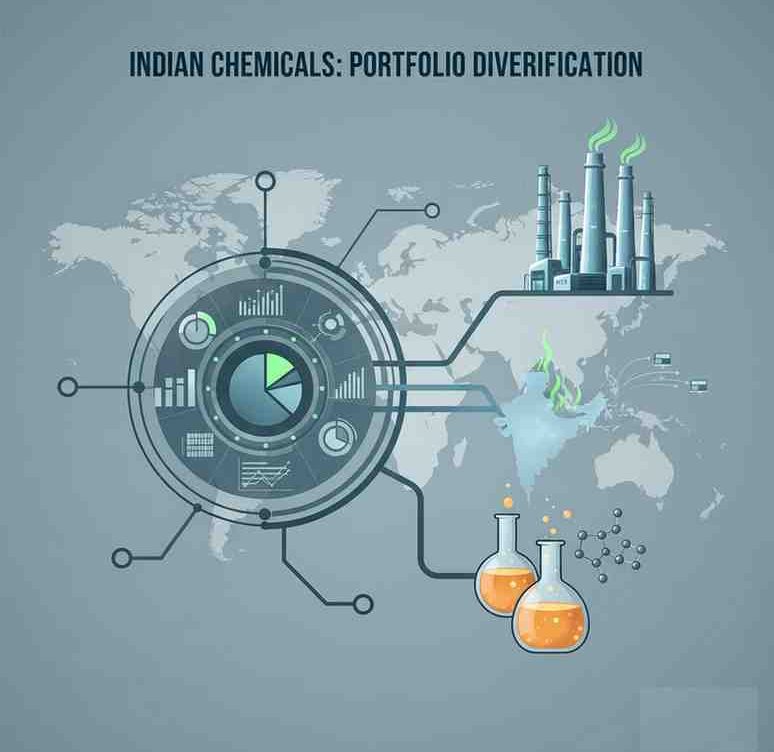
How to Build a Diversified Portfolio with Chemical Sector Exposure
How to Build a Diversified Portfolio with Chemical Sector Exposure
The Indian chemical industry has steadily evolved into a significant pillar of industrial growth, exports, and employment. For investors seeking stable, long-term opportunities, the sector presents a blend of cyclical resilience, export potential, and structural tailwinds. Integrating chemical sector exposure into a diversified investment portfolio can help balance risk, enhance returns, and align with India’s manufacturing and export growth story.
Thank you for reading this post, don't forget to subscribe!Understanding the Role of the Chemical Industry in Portfolio Management
The role of the chemical industry in portfolio management goes beyond short-term market movements. Chemical companies operate across diverse segments such as specialty chemicals, agrochemicals, industrial gases, and fertilizers — each influenced by different economic drivers. This multi-segment nature enables the sector to act as both a growth and defensive component within a portfolio.
The chemical sector’s contribution to the Indian economy is significant. It serves as a backbone for industries like pharmaceuticals, textiles, agriculture, and automotive manufacturing. This interconnectedness allows investors to gain indirect exposure to multiple sectors by investing in chemical companies, thereby improving portfolio diversification.
Why Chemical Stocks Strengthen a Diversified Portfolio
A well-structured diversified investment portfolio in the chemical sector offers exposure to companies with varied demand cycles and global linkages. While specialty chemical firms tend to benefit from innovation and exports, commodity chemical players respond to broader industrial demand trends. This combination helps mitigate sector-specific volatility.
From a diversification perspective, chemical stocks often have a low correlation with financials or IT sectors, which dominate Indian equity portfolios. Including them can help reduce overall portfolio risk while capturing growth driven by industrial and export expansion.
Investment Strategies for Chemical Sector Exposure
Building effective investment strategies for chemical sector exposure requires clarity on company types, value chains, and global positioning. Investors can approach this in three ways:
- Balanced Exposure Across Segments
A diversified approach should include a mix of specialty chemical stocks in India such as Aarti Industries, SRF, and Navin Fluorine, along with commodity chemical producers like Tata Chemicals and Gujarat Alkalies. Specialty firms offer margin stability through niche products, while commodity players provide cyclical opportunities tied to industrial demand.
- Evaluating Agrochemical and Fertilizer Companies
Agrochemical and fertilizer companies’ performance has shown resilience supported by India’s agricultural base and policy initiatives. Firms like UPL, Coromandel International, and Rallis India benefit from rising food demand and government subsidies. Their steady cash flows make them suitable for investors seeking stable returns within the chemical value chain.
- Thematic and Sustainable Investment Approach
With the rising emphasis on ESG investing, sustainable and green chemical investments in India are gaining traction. Companies transitioning to cleaner production methods or adopting energy-efficient processes align with global sustainability goals and can attract long-term institutional investors.
Macro Drivers and Policy Support
The government policies supporting chemical sector growth play a crucial role in shaping industry direction. The Production-Linked Incentive (PLI scheme for chemical manufacturers) aims to promote domestic manufacturing and reduce import dependence, particularly in high-value specialty chemicals.
Additionally, initiatives under the Make in India and Atmanirbhar Bharat programs are enhancing supply chain capabilities, encouraging capacity expansions, and attracting foreign investment. Such policy stability is essential for long-term planning and provides investors with visibility into sectoral growth.
Global and Domestic Demand Trends
Global demand trends in the chemical industry remain positive, driven by rising consumption in construction, packaging, and electronics. India has emerged as a key alternative manufacturing base amid supply chain diversification away from China. This shift has benefited Indian chemical exporters, particularly those in the specialty and performance chemical categories.
Domestic demand is supported by sectors such as agriculture, textiles, and pharmaceuticals. Together, these trends underpin the long-term outlook for Indian chemical companies, suggesting steady earnings visibility and growth potential.
Assessing Risks and Volatility in Chemical Industry Investments
Despite its growth prospects, investors must acknowledge risks and volatility in chemical industry investments. Price fluctuations in crude oil and feedstock materials, regulatory changes related to environmental norms, and currency movements can impact profitability.
Moreover, global demand slowdowns or supply chain disruptions can influence export-oriented companies. Hence, portfolio construction should balance between export-focused firms and those with strong domestic demand bases. Regular portfolio reviews help ensure that exposure levels remain aligned with market dynamics.
Diversification Across the Chemical Value Chain
Investors can achieve effective portfolio allocation across industrial and chemical stocks by spreading exposure across the value chain — from basic to specialty segments.
- Basic chemicals form the foundation of industrial manufacturing and tend to move with macroeconomic cycles.
- Intermediate and specialty chemicals offer innovation-led growth and margin stability.
- Agrochemical and performance material companies provide defensive characteristics due to steady agricultural and consumer-driven demand.
This commodity and specialty chemical diversification strategy ensures balanced participation across growth and cyclical phases, enhancing portfolio resilience.
Growth Opportunities in Indian Chemical Stocks
Growth opportunities in Indian chemical stocks are supported by export competitiveness, R&D capabilities, and capacity expansions. Many Indian companies are investing in value-added products and moving up the global supply chain. The shift toward specialty and performance chemicals enhances profitability and strengthens long-term fundamentals.
Furthermore, India’s increasing integration into global trade — supported by infrastructure improvements and free trade agreements — boosts the chemical sector’s value chain and export opportunities. Over the next decade, India is expected to capture a larger share of global chemical manufacturing, offering sustained opportunities for equity investors.
Strategic Considerations for Investors
For investors identifying the best chemical stocks in India for diversification, a few strategic principles can guide decision-making:
- Fundamental Strength: Focus on companies with healthy balance sheets, consistent cash flows, and prudent capital allocation.
- Regulatory Compliance: Preference should be given to firms aligned with environmental and safety norms.
- Operational Efficiency: Efficiency in raw material sourcing and production enhances profitability.
- Geographical Diversification: Firms with balanced exposure across domestic and export markets can better manage demand fluctuations.
- Long-Term Focus: Patience is key; the sector’s returns often materialize over multi-year cycles rather than short-term rallies.
Conclusion
Incorporating chemical sector exposure into a diversified portfolio can offer investors a unique mix of cyclical and structural growth. The sector’s links to multiple industries, policy support, and global competitiveness make it an essential component of India’s manufacturing and investment landscape.
By balancing exposure across specialty, commodity, and agrochemical segments, investors can capture both growth and stability while aligning with the broader long-term outlook for Indian chemical companies. A disciplined, research-driven approach—supported by policy awareness and diversification—can ensure that the chemical sector becomes a reliable contributor to long-term portfolio performance.
Related Blogs:
The Role of Chemicals in Pharma and Biotech: Opportunities for Investors
Healthcare, Pharma, and Biotech Stocks: Building a Diversified Healthcare Portfolio in India
Indian Healthcare Ecosystem: Diversification Strategies Across Pharma, Biotech, and Allied Sectors
5 Best Chemical Stocks for Long-Term Investment in India
Top 5 Chemical Stocks in India
Best Chemical Stocks in India
Best Healthcare Stocks in India
How Pharma, Biotech, and Technology are Shaping Healthcare Investments in India
Diagnosis to Treatment: Investing in the Integrated Healthcare Value Chain in India
Top 5 Healthcare Stocks in India
Best Diagnostic Device Stocks in India
Top 5 Pharma Stocks in India
Top 5 Biotech Stocks in India
Best Diagnostic Device Stocks in India
The Rise of Point-of-Care Diagnostics: Impacts on Pharma, Biotech, and Investment Opportunities in India
Healthcare Investing: A Guide to Pharma, Biotech, and Related Stocks in India
Disclaimer: This blog post is intended for informational purposes only and should not be considered financial advice. The financial data presented is subject to change over time, and the securities mentioned are examples only and do not constitute investment recommendations. Always conduct thorough research and consult with a qualified financial advisor before making any investment decisions.

